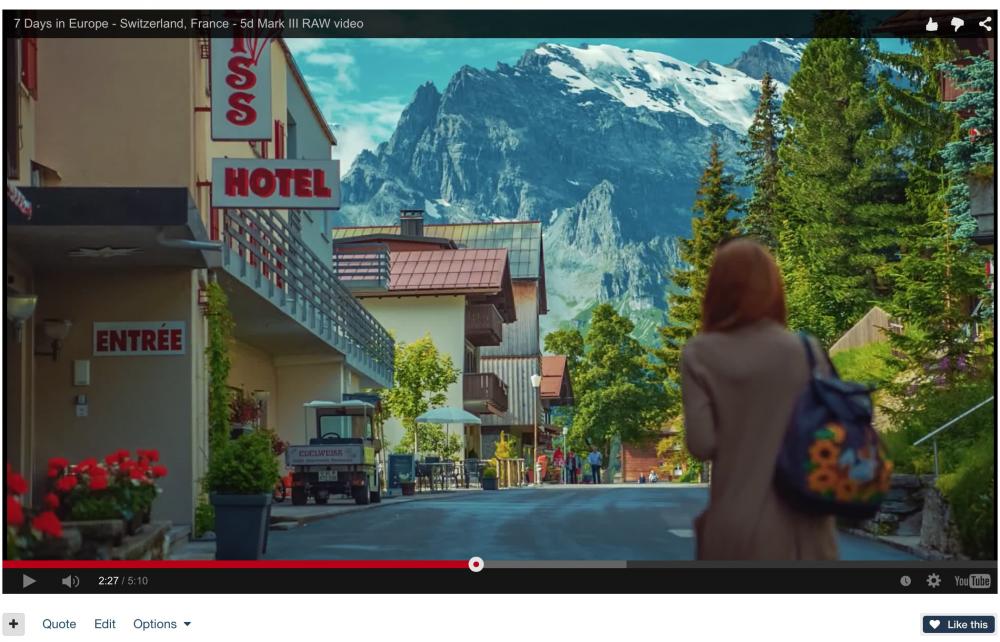-
Posts
1,503 -
Joined
-
Last visited
Content Type
Profiles
Forums
Articles
Everything posted by TheRenaissanceMan
-

LG Digital Cinema Display Review - 4096 x 2160 IPS impresses!
TheRenaissanceMan replied to Andrew Reid's topic in Cameras
Production monitors didn't use Plasma because you can't get smaller than 42", can't display larger than an 8-bit color space, and must use dithering to produce proper tonal variations. Many plasma panel image tests have shown models that are almost 100% Rec709 accurate, so I'm not sure where you're coming from here. I'm incredibly excited for the dawn of affordable OLED, even if they don't render motion as well as plasma. Perfect viewing angles, perfect uniformity, perfect blacks, excellent color accuracy. -
I totally love this as a short. It's a really fun, well shot parkour/martial arts flick with a twist; however, it's nothing they couldn't do with an RX10.
-
It's cool that you can push the footage that much without it falling apart. But should you? That shot looks oversaturated and pukey to me. It's the visual equivalent of drinking soda when you haven't for a couple years. It's nauseatingly sweet. Not to mention that all the foliage is suspiciously similar in color, and the sky is a flat, electric cyan. Yuck. The shot at 3:14 actually impresses me far more. No accounting for taste, I guess!
-
According to Art Adams (and confirmed by my own observations), the secret to Canon's skintones is that they push red slightly toward orange. Since most blemishes are redder than the surrounding skin, it makes them blend in and provides an overall creaminess that's not color accurate but is aesthetically pleasing. They also push green tones slightly toward blue to compensate for and contrast with the abundance of orange.
-
Yeah, how dare we have opinions! Bunch of slackers and amateurs...
-

Blackmagic URSA Mini - $2995 - official thread
TheRenaissanceMan replied to Andrew Reid's topic in Cameras
Doesn't the F55 have the exact same mechanical shutter? -
Panasonic does. They've been making almost all their own sensors lately. I'm not sure what leo's smoking, but the boys at Panasonic have huge fab facilities and make tons of image sensors. Their tech is great--even the E-M1 uses a Panasonic sensor--and once organic sensors hit, they'll be even better.
-
And here I am about to confess that I don't like anything Tattersall has ever shot... >_> There is no obligation on the part of a critic to "do better" or "walk the walk"--only an understanding of the form and the craft. Siskel and Ebert were not even trained in film theory, but no one can deny that they were extraordinary critics. You can't put down someone's honest opinion on a work of art just because they aren't as much of a "professional" as you (purportedly) are. Every artist takes the risk that someone may not like their work every time they create something. I find nothing inappropriate about Simon's critique of the work, especially not when most of the board seems to concur. Thank you! I don't think people realize just how un-cinematic Canon L glass is, but MAN does it make for plasticky images.
-

Blackmagic URSA Mini - $2995 - official thread
TheRenaissanceMan replied to Andrew Reid's topic in Cameras
http://www.fairchildimaging.com/catalog/focal-plane-arrays/scmos/ltn4625a -

Olympus E-M5 Mark II - love and hate at first sight
TheRenaissanceMan replied to Andrew Reid's topic in Cameras
I agree completely. One of MFT's advantages is that it lives, by necessity, on the bleeding edge. They don't use 3-5 year old sensors because they can't afford to. As it is, Panasonic and Olympus' image quality is within a stone's throw of APS-C, but offers a better selection of lenses--almost all of which are excellent by f/2.8, and many of which are excellent by f/2. http://www.dxomark.com/Reviews/Panasonic-Lumix-DMC-GX7-review-Closing-the-gap-between-APS-C-mirrorless-rivals/Panasonic-Lumix-DMC-GX7-Versus-Olympus-PEN-E-P5-Versus-Sony-NEX-6-Results-are-close Andrew, you say MFT has a hard time achieving "the full frame look." What if I don't want the full frame look? There's nothing inherent to photographic 35mm/VistaVision that makes it the best sensor size for video. My style focuses heavily on subjects' relationship to their background and composing with more than one plane of depth. Unless I'm going for something intimate or a detail shot, I like to stick with f2.8 (if not f/4) on MFT. This provides just enough separation to focus the eye without flattening my carefully scouted locations and (hopefully) interesting set dressing into blurry, 2-dimensional mush. I also like to light my interiors and shape the light in my exteriors, which makes low light much less of a priority. Plus, I hate bad focus pulling in movies. It screams "amateurish" as much as micro jitters. At f/2.8-f/4 on MFT, me or my focus puller (if I have one) have a much better chance to nail it. With that in mind, full frame holds no advantage for me. If I'm shooting my GX7 at ISO 800 and f/4, I'd have to shoot an A7S or whatever at ISO 3200, rendering DR and noise virtually identical, but with the added advantage of Panasonic's color science (which is really good once you learn your way around it) and great tonality. Add to that the small, wonderful Olympus primes and the cinematic as hell Voigtlanders, and you have a recipe for great imagery. If you enjoy the look, that's awesome! I look forward to seeing your work with it. But I get perturbed sometimes when full framers dismiss other aesthetics as somehow inferior to their chosen sensor size. Cheers! -
That's really interesting. In the samples I've seen, at least, the difference between 8-bit and 10-bit has been hugely obvious (256 shades of gradation per color channel vs 1024 shades), whereas I just see slightler thicker color in 8-bit 4:2:2 footage. Do you have links to any such demonstrations between the two? Because if 4:2:2 is really what I'm responding to, that's much easier to find than 10-bit.
-
If you want more information on the Blackmagic Pocket's ins and outs, I'd recommend checking out Shane Hurlbut's tests: https://www.hurlbutvisuals.com/blog/?s=blackmagic+ Mattias Burling's reviews and tutorials: And the Blackmagic Pocket Cinema Camera series on DrewNetwork: https://www.youtube.com/user/drewnetwork/search?query=blackmagic+pocket
-
That all depends: what stage are you at in your education, and what do you want to learn? If you want to keep it simple and learn storytelling, lighting, and composition without the encumbrance of a big technical learning curve, I've found the RX10 to be a great learning tool. A do-it-all lens, good quality, helpful features, stabilization for handheld shots. It's a simple camera that gets out of the way and lets you work. On the other hand, maybe you want to be a colorist/AC/DoP. Maybe you have more experience with the basics and want to get more technical with your education. In that case, I think the BMPCC makes a ton of sense. It's cheap--you can get a full kit, ready to shoot for $650 if you hunt for used deals--it has great image quality, and it's the digital equivalent of shooting 16mm film, which has been used to train film students for decades. If you want something in between or have a particular style that requires something these cameras lack, the G6, D5300, A6000, LX100, or GX7 are probably the best options. They're affordable, offer great image quality, and have established user bases to draw on for tips and tricks. Without knowing your style, your taste, or where you are in the learning process, it's hard to get more specific. The best way to decide on a camera, as always, is to go search them on Vimeo and see what you like. Ultimately, they're your films. The look should be borne out of what you like, not what someone on the internet told you. Best of luck!
-
Don't you mean 4:2:2 10-bit? I was under the impression the GH4 did 10-bit HDMI out.
-

Sony FS7 Review – Shooting 150fps in the dead of night
TheRenaissanceMan replied to Andrew Reid's topic in Cameras
It doesn't NEED it, but I'm curious how the video holds up in terms of DR and banding without the added variables of third party H.265 conversion. -
Could we maybe get back on track here? I'm interested to see how the video quality of pixel-for-pixel sampling compares to full sensor downsampling in terms of moire, aliasing, color, DR, and rolling shutter. We've never seen the same sensor utilized both ways like this--it might provide some cool insights into the pros and cons of each method. However, like any camera, I'll be waiting until there's a used market and established tests before I put down money on it. Looking forward to Andrew's review!
-

Olympus E-M5 Mark II - love and hate at first sight
TheRenaissanceMan replied to Andrew Reid's topic in Cameras
Actually, I've had really excellent results with my RX10 in that regard. The only initial issue with it was the weak AVCHD codec, which has since been fixed with the addition of a 50mbps XAVC-S option. Small, lightweight, weather sealed, killer lens, excellent stabilization, a great feature set, and video quality indistinguishable from my GH3. It's so versatile, in fact, that I'm considering selling my GH3 (while it still has decent resale value) and picking up the Blackmagic Pocket; the Blackmagic for tripod/studio/cinematic work, and the RX10 as my handheld/crane cam/ENG camera. -

“Maestro 4K” cinema camera powered by Nvidia with H.265 codec
TheRenaissanceMan replied to Andrew Reid's topic in Cameras
Double post -

“Maestro 4K” cinema camera powered by Nvidia with H.265 codec
TheRenaissanceMan replied to Andrew Reid's topic in Cameras
They've been making 90% of that camera for years? What does that even mean? And even if they've made the body and electronics, that doesn't mean their processing pipeline/encoding/CFA is up to snuff. In fact, Art Adams has some serious doubts about the camera's abilities. http://www.dvinfo.net/article/acquisition/a-critical-look-at-cions-new-demo-reel.html A sales rep "pretty much indicating" it was the same sensor is not proof nor proper confirmation. I have no doubt they considered all their options before purchasing a sensor, but that doesn't necessarily make it the same as Blackmagic's. -

“Maestro 4K” cinema camera powered by Nvidia with H.265 codec
TheRenaissanceMan replied to Andrew Reid's topic in Cameras
You say "I would prefer AJA's expertise on this." You're aware that the Cion is AJA's first camera, right? And I must second bertzie's question: Is there definitive proof that the BMPC/Ursa/Cion share a sensor? Because if not, I would consider editing the article. Many people follow EOSHD as a camera news site, and news should be verified before it is reported. Still, thank you for shining a light on the Maestro. Excited to hear more! -
Indeed! Weirdly, you're best off getting the 50mm f/1.8--metal mount and a nice wide focusing ring. The 50/1.8 II focus ring is not only tiny and plastic, but has several degrees of play before the helicoid actually engages. AVOID.
-
I don't get the obsession with 85mm lenses for cinema use. It's a little on the long side for a proper MCU, but not quite long enough for ECU/shallow focus/compressed perspective/detail shots like a 100mm. If you've never used a 75mm, borrow someone's APS-C camera and try a 50mm. My friend lent me his Sony 50mm f/1.8 OSS and A6000 for a 48 hour film project once, and I almost never felt the need to switch to my Minoltas--in fact, we shot the entire feature with nothing but that lens. When voting on these focal lengths, think outside the box that photographic lenses may have trained you into. You may be surprised.



